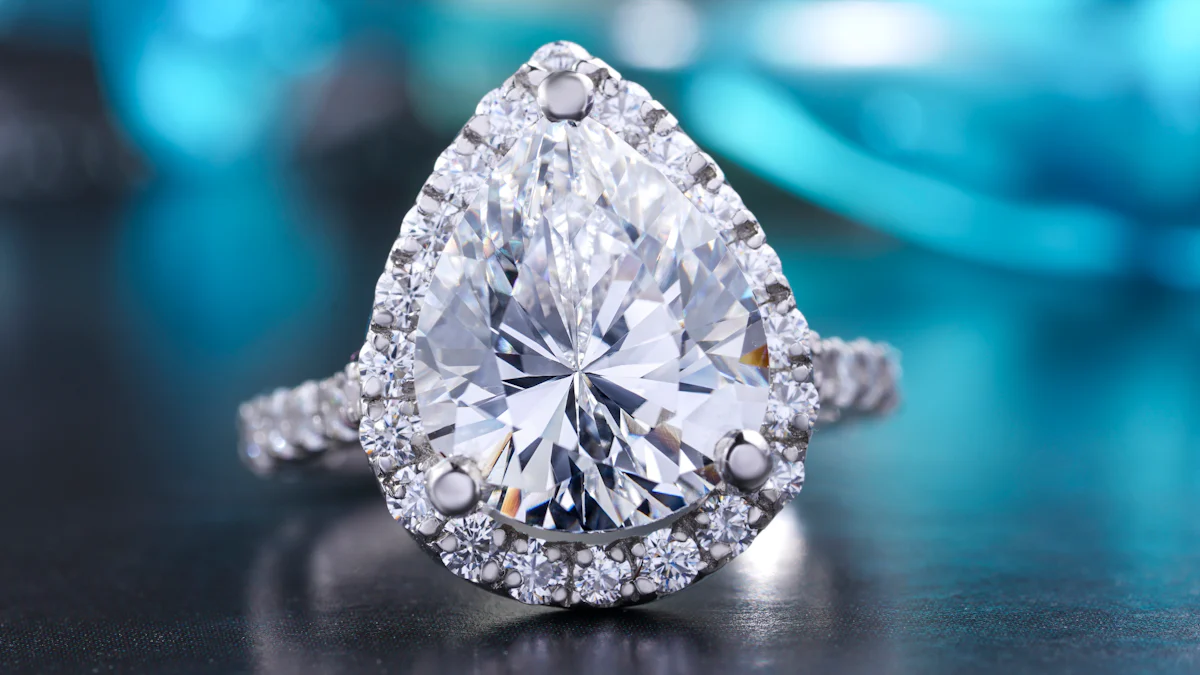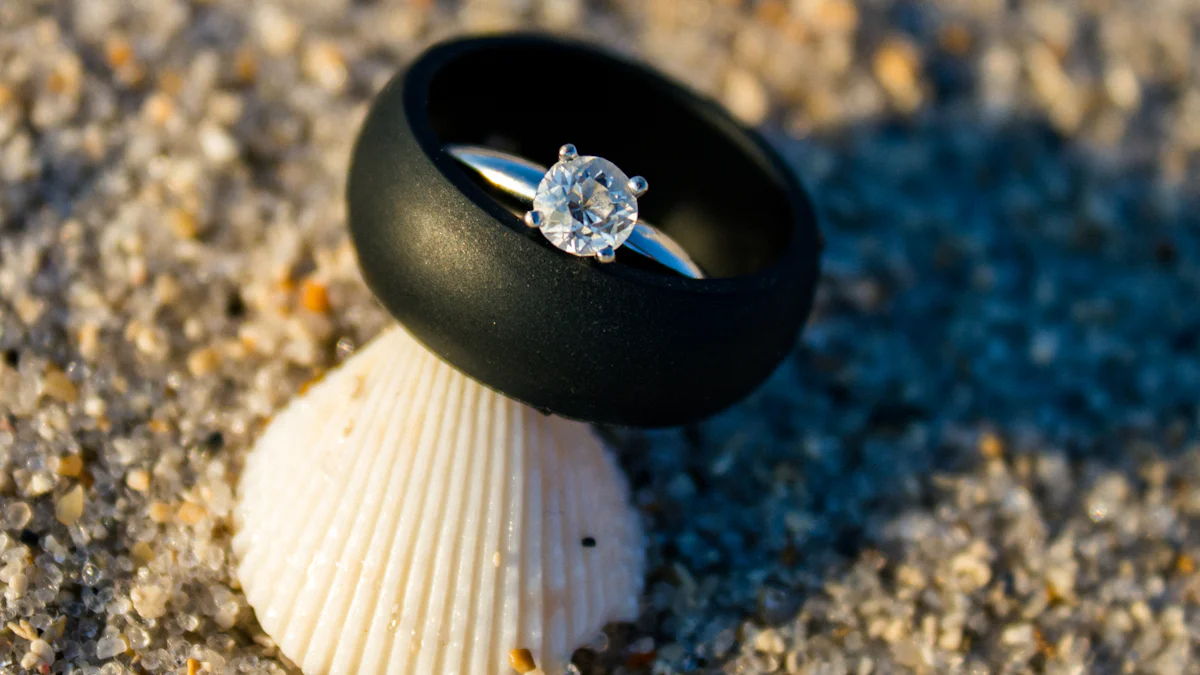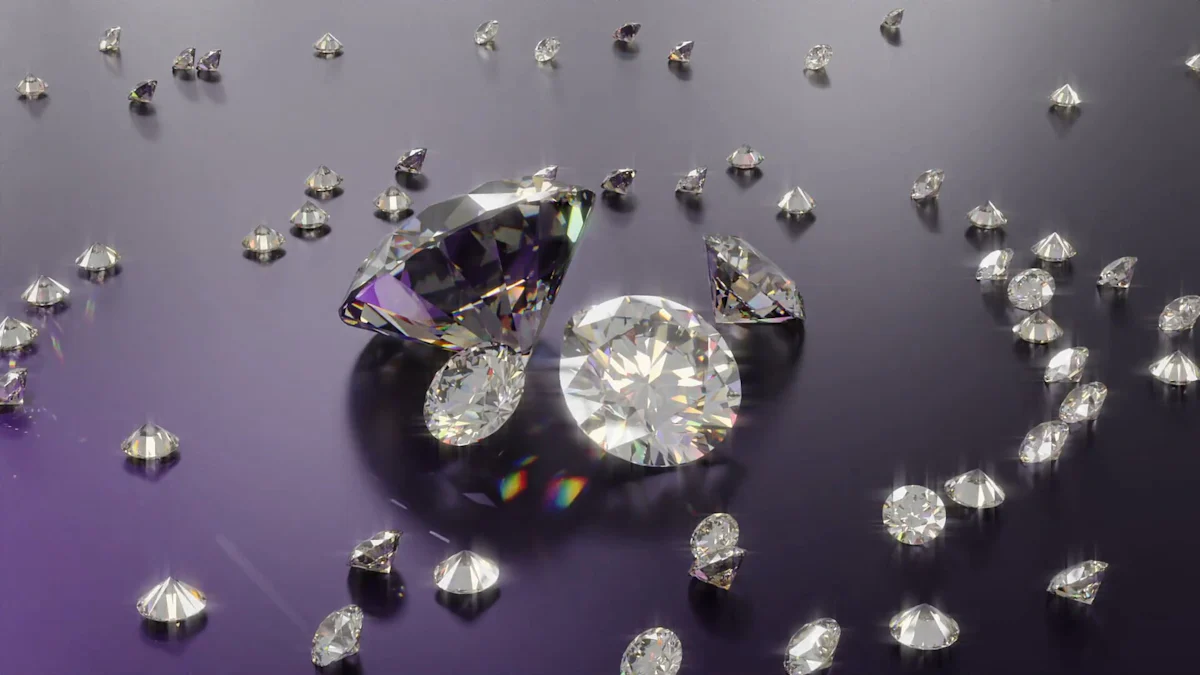Tips for Buying VS or VVS Diamonds

When choosing a diamond, clarity plays a huge role in determining its beauty and value. It reflects how free the stone is from inclusions or blemishes, which can affect its brilliance. VS or VVS diamonds stand out for their exceptional quality, but they differ in subtle yet important ways. VS diamonds offer a balance of high quality and affordability, making them a favorite for budget-conscious buyers. On the other hand, VVS diamonds boast near-flawless clarity, appealing to those seeking perfection. Your decision should align with your budget, personal preferences, and how you plan to wear the diamond.
Understanding VS and VVS Diamonds

When shopping for diamonds, understanding the differences between VS and VVS clarity grades can help you make an informed decision. Let’s break down what each clarity grade means and how they are evaluated.
What Is a VS Diamond?
Definition and Clarity Grade Explanation
A VS diamond, short for "Very Slightly Included," contains small inclusions that are visible under 10x magnification. These inclusions are typically minor and do not affect the diamond's brilliance or sparkle. On the diamond grading scale, VS diamonds rank below VVS but above SI (Slightly Included) diamonds. They strike a balance between quality and affordability, making them a popular choice for many buyers.
Subcategories: VS1 vs. VS2
VS diamonds are further divided into two subcategories:
- VS1 Diamonds: These have fewer and smaller inclusions compared to VS2 diamonds. In most cases, even under magnification, spotting these imperfections requires a trained eye.
- VS2 Diamonds: These contain slightly more noticeable inclusions than VS1 diamonds. However, they remain eye-clean, meaning you won’t see any flaws with the naked eye.
If you’re looking for a diamond that offers excellent value without compromising on appearance, a VS diamond might be the right choice.
What Is a VVS Diamond?
Definition and Clarity Grade Explanation
A VVS diamond, or "Very Very Slightly Included," represents a higher level of clarity. These diamonds have tiny inclusions that are extremely difficult to detect, even under 10x magnification. On the clarity scale, VVS diamonds are just one step below internally flawless (IF) diamonds. Their exceptional clarity ensures that light passes through the stone without interference, enhancing its brilliance.
Subcategories: VVS1 vs. VVS2
Like VS diamonds, VVS diamonds are also divided into two subcategories:
- VVS1 Diamonds: These are nearly flawless, with inclusions so minute that even expert gemologists may struggle to find them under magnification. They are ideal for those seeking perfection.
- VVS2 Diamonds: These have slightly more inclusions than VVS1 diamonds, but the differences are negligible to the untrained eye. They still maintain an eye-clean appearance and exceptional clarity.
If you prioritize clarity and want a diamond that exudes luxury, a VVS diamond could be your perfect match.
How Are Clarity Grades Determined?
Role of Magnification and Gemological Standards
Clarity grades are assigned based on the four Cs of diamonds, with clarity being one of the most critical factors. Gemologists use 10x magnification to examine the diamond for inclusions and blemishes. They assess the size, number, location, and visibility of these imperfections. The diamond grading scale, established by the Gemological Institute of America (GIA), serves as the standard for evaluating clarity.
Common Inclusions Found in VS and VVS Diamonds
Inclusions in VS and VVS diamonds are typically microscopic and do not affect the diamond’s overall beauty. Common inclusions include:
- Pinpoints: Tiny dots that are often invisible without magnification.
- Feathers: Small cracks that don’t compromise the diamond’s durability.
- Clouds: Groups of pinpoints that may appear hazy under magnification.
While VS diamonds may have slightly more noticeable inclusions than VVS diamonds, both clarity grades ensure a stunning, eye-clean appearance.
Comparing VS and VVS Diamonds

When deciding between VS and VVS diamonds, understanding their differences can help you make the right choice. Let’s explore how they compare in clarity, price, and suitability for various purposes.
Clarity and Appearance
Visibility of inclusions to the naked eye
Both VS and VVS diamonds appear flawless to the naked eye. A VS diamond, or "Very Slightly Included," may have small inclusions, but these are invisible without magnification. On the other hand, VVS diamonds, or "Very Very Slightly Included," have inclusions so tiny that even under 10x magnification, they are hard to spot. This makes VVS diamonds a top choice for those who value near-perfect clarity.
Fun Fact: VVS1 diamonds are so clear that even expert gemologists often struggle to detect their inclusions under magnification.
Differences under magnification
Under magnification, the differences between VS and VVS diamonds become more apparent. VS diamonds may show slightly larger or more noticeable inclusions compared to VVS diamonds. However, these inclusions rarely affect the diamond's brilliance. VVS diamonds, with their exceptional clarity, allow light to pass through with minimal interference, resulting in unmatched sparkle. If you’re someone who appreciates perfection under the loupe, VVS diamonds might be worth the investment.
Price and Value
Cost differences between VS and VVS diamonds
The price gap between VS and VVS diamonds can be significant. VVS diamonds are rarer and command higher prices due to their superior clarity. On average, a VVS diamond can cost 15% to 20% more than a comparable VS diamond. This price difference reflects the rarity and desirability of VVS diamonds. If you’re working with a tighter budget, VS diamonds offer excellent value without sacrificing much in terms of appearance.
Value considerations for different budgets
For budget-conscious buyers, VS diamonds strike a perfect balance between quality and affordability. They provide an eye-clean appearance at a more accessible price point. VVS diamonds, while more expensive, cater to those who prioritize luxury and exclusivity. If you’re buying a diamond for an engagement ring or a special occasion, consider how much clarity matters to you versus other factors like carat size or cut.
Suitability for Different Purposes
Engagement rings and other jewelry
When choosing a diamond for an engagement ring, think about how it will be worn. VS diamonds are ideal for everyday wear because they combine beauty and durability at a reasonable price. VVS diamonds, with their near-flawless clarity, make a statement piece for those who want something truly extraordinary. Whether you’re buying a diamond for a ring, necklace, or earrings, both options ensure stunning results.
Resale and investment potential
Diamonds are not always the best investment, but clarity can influence resale value. VVS diamonds, being rarer, may hold their value better over time. However, the resale market for diamonds often prioritizes carat weight and overall quality over clarity alone. If you’re buying a diamond as an investment, consider consulting a professional jeweler to understand its long-term potential.
Tips for Buying VS or VVS Diamonds
When it comes to buying a diamond, making the right choice requires careful consideration. Whether you’re drawn to VS diamonds for their balance of quality and affordability or VVS diamonds for their near-flawless clarity, understanding your priorities will help you find the perfect gem. Let’s explore some practical tips to guide your decision.
Consider Your Budget
Balancing clarity with other factors like carat and cut
Your budget plays a significant role in determining whether VS or VVS diamonds are the right fit. While clarity is important, it’s just one of the four Cs of diamonds. Carat weight and cut also impact the overall beauty and value of the stone. If you’re working with a limited budget, consider prioritizing a well-cut VS diamond. A high-quality cut enhances brilliance, often making inclusions less noticeable.
On the other hand, if you have more flexibility in your budget, a VVS diamond offers unmatched clarity. Its near-perfect appearance ensures a luxurious sparkle that’s hard to beat. Remember, balancing clarity with carat size and cut can help you maximize the value of your investment.
When to prioritize VS diamonds over VVS diamonds (and vice versa)
Choosing between VS and VVS diamonds depends on your preferences and financial plan. If you’re looking for a stunning diamond without overspending, VS diamonds provide excellent value. They appear flawless to the naked eye and cost significantly less than VVS diamonds.
However, if you’re seeking perfection and willing to invest in a premium gemstone, VVS diamonds are worth considering. Their rarity and exceptional clarity make them ideal for those who want a truly special piece. As one expert puts it:
"If you desire the highest possible clarity and are willing to invest in a premium gemstone, VVS diamonds are an excellent choice. For great value, VS diamonds provide a fantastic balance of clarity and affordability."
Think About the Purpose
Everyday wear vs. special occasion jewelry
How you plan to wear the diamond should influence your decision. For everyday wear, such as an engagement ring, VS diamonds are a practical choice. They offer durability and beauty without the higher price tag of VVS diamonds.
For special occasion jewelry, like a statement necklace or earrings, VVS diamonds can elevate the piece to a new level of elegance. Their superior clarity makes them perfect for showcasing in designs meant to dazzle. Think about how often you’ll wear the diamond and whether it needs to withstand daily use or shine on rare occasions.
Personal preferences for clarity and appearance
Your personal taste matters most when choosing between VS or VVS diamonds. Some people value the exclusivity and perfection of VVS diamonds, while others prefer the balance of quality and cost that VS diamonds provide. Both options deliver stunning results, so focus on what feels right for you. Ask yourself: Do you prioritize flawless clarity, or are you more concerned with size and sparkle?
Check Certification
Importance of GIA or AGS certification
Always ensure the diamond you purchase comes with proper certification. Reputable organizations like the Gemological Institute of America (GIA) or the American Gem Society (AGS) provide detailed reports on diamond clarity, cut, carat, and color. These certifications guarantee that the diamond meets strict quality standards, giving you confidence in your purchase.
Avoiding uncertified diamonds
Avoid buying uncertified diamonds, even if they seem like a bargain. Without certification, you can’t verify the diamond’s authenticity or quality. This increases the risk of overpaying for a stone that doesn’t meet your expectations. Stick to certified diamonds to ensure you’re getting exactly what you pay for.
Work with a Trusted Jeweler
When buying vs diamonds or vvs diamonds, working with a trusted jeweler can make all the difference. A reliable jeweler ensures you get the quality you’re paying for and helps you make an informed decision. Here’s how you can find one and what to ask during the process.
How to Find a Reputable Jeweler
Finding a jeweler you can trust starts with research. Look for jewelers with strong reputations in your community or online. Check reviews on platforms like Google or Yelp to see what other customers say about their experiences. Positive feedback about honesty, professionalism, and customer service is a good sign.
Ask friends or family for recommendations. Personal referrals often lead to jewelers who prioritize customer satisfaction. If someone you trust had a great experience, chances are you will too.
Visit the jeweler’s store or website. A professional jeweler will have a clean, organized space and knowledgeable staff. They should also provide detailed information about vs diamonds and vvs diamonds without pressuring you to buy. Transparency is key.
Asking the Right Questions During the Buying Process
When you meet with a jeweler, asking the right questions can help you feel confident in your purchase. Start by inquiring about the diamond’s certification. Ask if the diamond comes with a report from a reputable organization like GIA or AGS. Certification ensures the diamond’s quality matches its description.
Next, ask about the differences between vs diamonds and vvs diamonds. A trustworthy jeweler will explain these clarity grades in simple terms. They’ll also help you understand how clarity impacts the diamond’s appearance and price.
Don’t forget to ask about the jeweler’s return or exchange policy. This gives you peace of mind in case you change your mind after the purchase. A reputable jeweler will offer fair policies that protect your investment.
Finally, ask to see the diamond under magnification. This allows you to examine the inclusions and compare vs diamonds to vvs diamonds firsthand. A good jeweler will guide you through this process and answer any questions you have.
“A trusted jeweler doesn’t just sell diamonds—they educate you about your options and help you make the best choice for your needs.”
Choosing between VS or VVS diamonds comes down to your priorities. VS diamonds offer a balance of beauty and affordability, while VVS diamonds provide unmatched diamond clarity for those seeking perfection. Think about your budget, how you’ll wear the diamond, and what matters most to you—clarity, size, or sparkle. Remember, there’s no one-size-fits-all answer. Consulting a trusted jeweler can help you navigate these options and find the diamond that fits your needs perfectly. Make your decision with confidence, knowing you’ve considered all the key factors.
FAQ
What are VS diamonds?
VS diamonds, short for "Very Slightly Included," have minor inclusions that are difficult to spot even under 10x magnification. These inclusions don’t affect the diamond’s brilliance or sparkle, making VS diamonds a popular choice for those seeking high quality at a more affordable price. They strike a balance between clarity and value, offering an eye-clean appearance without the premium cost of higher clarity grades.
What are VVS diamonds?
VVS diamonds, or "Very Very Slightly Included," represent a higher clarity grade than VS diamonds. Their inclusions are so tiny that even under magnification, they’re nearly impossible to detect. These diamonds are rarer and more sought after, often appealing to buyers who prioritize perfection and exclusivity. If you’re looking for a diamond with exceptional clarity, VVS diamonds are an excellent option.
Which diamonds are better: VS or VVS?
The answer depends on your priorities. VVS diamonds have fewer inclusions and higher clarity, making them technically better in terms of quality. However, the visual difference between VS and VVS diamonds is minimal to the naked eye. If you value perfection and rarity, VVS diamonds are the better choice. For those seeking a balance of beauty and affordability, VS diamonds offer excellent value.
Is it worth buying VVS diamonds?
In most cases, paying extra for a VVS diamond isn’t necessary if you’re on a budget. VS diamonds often look identical to VVS diamonds when viewed without magnification. However, VVS diamonds may be worth the investment for larger stones or certain shapes, like emerald cuts, where inclusions are more visible. If you’re buying for a special occasion or want a truly flawless appearance, VVS diamonds can be a worthwhile splurge.
What is the difference between VS and VVS clarity diamonds?
The main difference lies in the size and visibility of inclusions. VS diamonds have slightly more noticeable inclusions under magnification compared to VVS diamonds. However, both clarity grades appear eye-clean to the naked eye. VVS diamonds are rarer and command higher prices due to their near-flawless clarity, while VS diamonds offer a more budget-friendly option without compromising on beauty.
Are VVS diamonds real?
Yes, VVS diamonds are absolutely real. The term "VVS" refers to their clarity grade, which is determined by expert gemologists using strict standards. To ensure you’re purchasing a genuine VVS diamond, always look for certification from reputable organizations like the GIA or AGS. This guarantees the diamond’s authenticity and quality.
VVS1 vs. VVS2 Diamonds: Which one is better?
Both VVS1 and VVS2 diamonds offer exceptional clarity, but VVS1 diamonds have fewer and smaller inclusions, making them closer to flawless. The difference between the two is negligible to the naked eye, so your choice may come down to budget. VVS1 diamonds are typically more expensive, while VVS2 diamonds provide similar visual quality at a slightly lower cost.
Why are VVS diamonds more expensive than VS diamonds?
VVS diamonds are rarer than VS diamonds, which makes them more valuable. Their higher clarity grade means fewer inclusions, resulting in a cleaner and more brilliant appearance. This rarity and perfection drive up their price. On average, VVS diamonds can cost 15% to 20% more than comparable VS diamonds.
Should I prioritize clarity over carat size?
It depends on your personal preferences. If you want a diamond that looks flawless under close inspection, prioritize clarity. However, if size matters more to you, consider choosing a slightly lower clarity grade, like VS, and investing in a larger carat weight. A well-cut diamond can enhance brilliance, making inclusions less noticeable.
How can I tell if a diamond is certified?
Look for a grading report from reputable organizations like the GIA (Gemological Institute of America) or AGS (American Gem Society). These certifications detail the diamond’s clarity, cut, carat, and color. Always ask the jeweler to provide this documentation before making a purchase. Avoid uncertified diamonds, as they may not meet the quality standards you expect.
See Also
A Comprehensive Look At Engagement Ring Diamond Cuts
Your Ultimate Guide To Selecting A White Diamond Ring
Essential Elements That Influence Diamond Ring Prices
Tips For Spotting Authentic Diamond Rings At Home
Everything You Need To Know About Choosing A Diamond Ruby Ring

